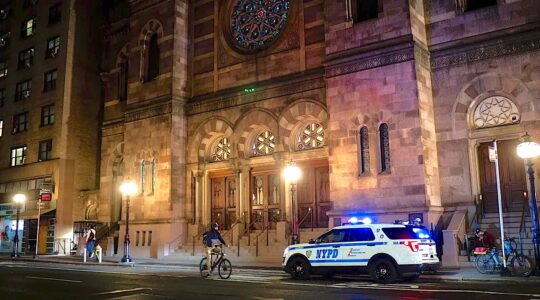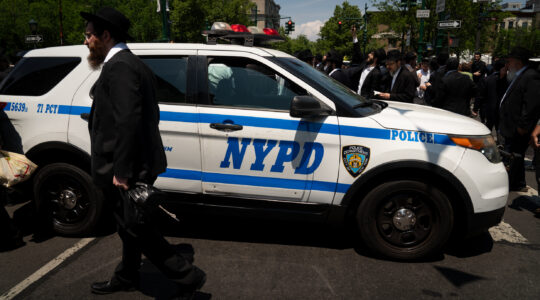I wear a necklace with a hand-shaped charm that’s called a hamsa as a point of Jewish pride. In the aftermath of the terrorist attacks in Paris in January, I was asked at a gathering in Manhattan if I wore it because I was Muslim.
“Je suis juif, I am Jewish,” I replied, flooded by thoughts of the hostages murdered at the kosher grocery store just outside Paris.
“Well, that’s surprising. The only other woman I know who wears one is Muslim, and she probably would be on the other side of where you stand,” he said.
His words sparked an unfading memory: of having been held hostage on March 9, 1977 by armed Muslim gunmen in a “Jewish” building, the B’nai B’rith headquarters, in Washington, D. C., where I then worked. That was when 12 Hanafi Muslims, armed with shotguns and machetes, seized three buildings in Washington: the District Building (Washington’s city hall), the Islamic Center, and B’nai B’rith. The total number of hostages taken at all three locations came to 149, and the ordeal — which left two people dead and others seriously injured — lasted 39 hours.
Back then I hadn’t worn a hamsa, and even if I had it would not have provided the supposed protective power, accorded by Jewish folklore, to shield against the evil eye, which explains why an eye often appears in the palm part of the “hand.” And, as the conversation was reminding me, the hamsa is also a common motif in Islamic art, where it represents the Hand of Fatima, in honor of Muhammad’s daughter. It appears in Christian art, too, as the Hand of Mary. Because the three religions all stem from the same general region in the Mediterranean, this commonality in symbol and meaning should not be surprising.
And yet, religious enmities being what they are, it can astonish us to discover any mutuality.
That’s why it’s headline news that a young Muslim employee heroically saved Jewish customers at the Paris supermarket.
And that’s why I keep turning back to 1977, when the outcome of that long-ago siege would almost undoubtedly have been far worse had it not been for the intervention of — yes — Islamic peace makers.
With more than 100 of us at the B’nai B’rith building as his literally captive audience, Hamaas Abdul Khaalis, the lead hostage-taker and head of the Hanafi Muslim group, harangued us with endless anti-Jewish rants. Ominously, he told us that nobody promised us tomorrow. Whatever God we prayed to, he added, we should pray.
But it wasn’t until after we were freed that we discovered that the most significant prayers appeared to have come from the Koran, as conveyed by Ambassadors Ashraf Ghorbal of Egypt, Ardeshir Zahedi of Iran and Sahabzada Yaqub-Khan of Pakistan, who had agreed to meet with Khaalis at the request of the D.C. police department and with the approval of the State Department and President Jimmy Carter.
During their three-hour meeting with Khaalis in the B’nai B’rith building, the three ambassadors read extensively from the Koran, with Ghorbal of Egypt quoted as describing these passages as “songs of compassion, forgiveness, understanding.” Suggestions for the particular passages came from an Islamic scholar, Mohammad Javad Farzaneh. “And let not the hatred of some people in once shutting you out of the sacred mosque lead you to transgression and hostility on your part,” one passage read. “Help ye one another in righteousness and piety, but help ye not one another in sin and rancor.”
The appeals worked. Although the police — and we who were held hostage inside — had feared the siege would end violently, shortly after this session with the ambassadors, Khaalis agreed to release everyone in all three buildings.
Support the New York Jewish Week
Our nonprofit newsroom depends on readers like you. Make a donation now to support independent Jewish journalism in New York.
Even then, the strategy seemed improbable. The Shah still ruled Iran, and Egypt’s then president, Anwar Sadat, had not yet begun the historic dialogue with Israel that led to the 1979 peace accords at Camp David. Afghanistan’s government was teetering, but the Soviet Union had not yet invaded, and the Taliban party did not exist. Nor were we in the United States as aware as (in retrospect) we already should have been of the threats posed by Islamic fundamentalists.
But so saturated are we today with anti-Islamic fear and mistrust that this real-life fable of the multiple leaps of faith taken — by the Islamic ambassadors who were willing to negotiate with a man of their own faith, as well as by the police and government officials who endorsed the strategy — seems all the more remarkable for the choice made then to chance crossing a deep chasm.
It will take far more than the thought of a hamsa to do it — but at the very least, let it remind us of what we share.
Diane Cole, the author of the memoir “After Great Pain: A New Life Emerges,” writes for The Wall Street Journal among other publications.
The New York Jewish Week brings you the stories behind the headlines, keeping you connected to Jewish life in New York. Help sustain the reporting you trust by donating today.




